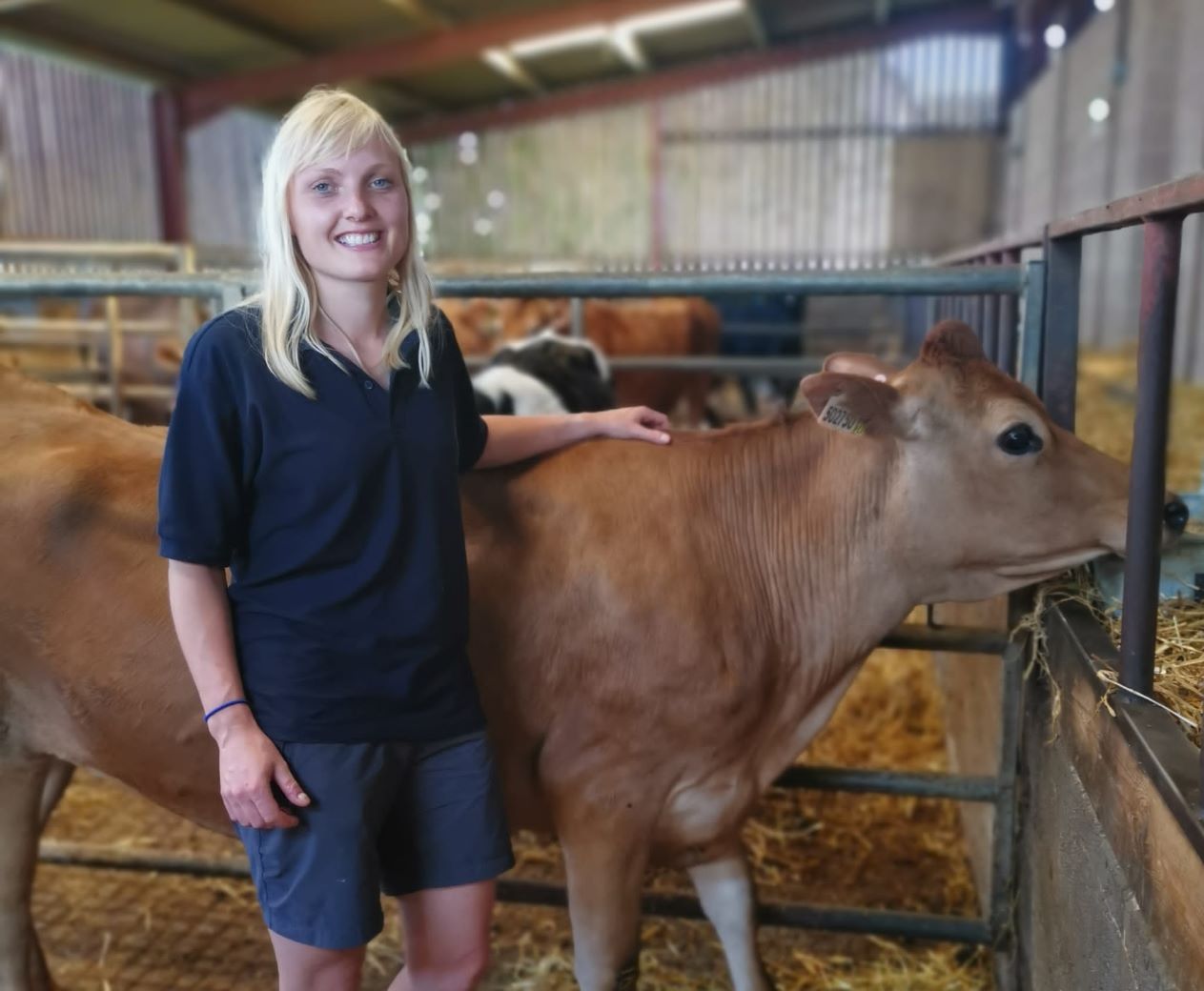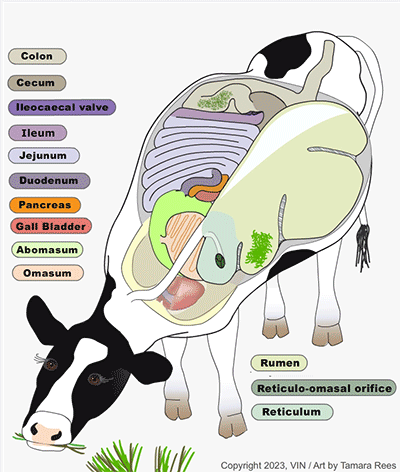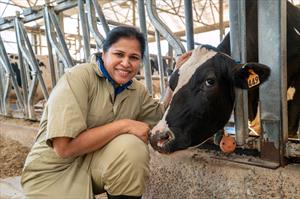Dr. Emma Stuart

Photo courtesy of Paragon Veterinary Group
Dr. Emma Stuart, a large animal practitioner in England’s Cumbria region, says veterinarians who work with farmers on environmental sustainability improvements can make a difference in herd health, too.
 Listen to this story.
Listen to this story.
When Dr. Emma Stuart visits clients in the rolling hills of England's Cumbria region, she doesn't limit herself to performing bovine tuberculosis tests, fertility exams and other typical work. The large animal veterinarian also talks cow burps.
Methane, emitted by cows as a digestive byproduct, is a potent greenhouse gas. A happier, healthier herd, Stuart informs farmers, yields more product per unit of methane emitted, lowering the herd's impact on the environment — and boosting farmers' profits, to boot.
"If we can produce more milk and meat from less animals, we've got a twofold benefit," Stuart told the VIN News Service. "We're not only potentially pulling methane from the atmosphere, but we're feeding more people with less resources."
Stuart is better placed than most to ruminate on the finer points of farm efficiency and environmental sustainability, having also worked as an agricultural consultant. Nowadays, when she's not competing in fell-running events — a sport that involves running off-road in hilly terrain — she splits her time between working as a large animal veterinarian, advising on advanced reproductive technologies and studying for a master's in animal nutrition.
No matter their background, Stuart encourages all large animal veterinarians to bone up on sustainability-related topics, whether it's methane emissions, soil quality or water use, as the effects of a changing climate become increasingly apparent.
Assessing how much methane cows belch and how it can be curbed is gaining heightened attention in industry and academia, including at many of the world's veterinary and agricultural science schools.
Methane mitigation efforts range from improving herd health and identifying and breeding animals with a genetic predisposition toward producing less methane to investigating how food additives, such as seaweed, synthetic compounds and even kangaroo dung, can suppress methane formation in animals' guts.
The flurry of research and investment rests on the promise that fast gains can be achieved in the battle against climate change. Methane (CH4) is the second-largest contributor to global warming behind carbon dioxide (CO2), accounting for around 20% of global greenhouse gas emissions, according to the Intergovernmental Panel on Climate Change.
Some methane comes from natural sources, like wetlands, but around 60% is estimated to stem from human activity, such as agriculture and energy production. The agriculture sector accounts for about 40% of those human-caused emissions, according to the United Nations Environment Programme. Most of that methane is emitted by belching cows and smaller ruminants such as sheep and goats.
Once emitted, methane breaks down in the atmosphere much more quickly than carbon dioxide, lasting about a decade compared with centuries for the latter. Methane's molecular structure, however, makes it more apt for trapping heat, to the point that even after accounting for its shorter persistence, it still has a global warming potential 28 times as great as carbon dioxide on a 100-year timescale.
The extent of the agriculture sector's contribution to global warming nevertheless remains hotly debated. A white paper by a University of California, Davis, researcher downplaying the industry's contribution in the United States has gained a lot of traction. It has been criticized, though, for being largely funded by agribusinesses and rebutted by researchers at Johns Hopkins University who urge Americans to eat less meat. Those differences aside, few disagree that curbing methane emissions from livestock offers rapid benefits in mitigating warming — a fact that's not lost on Stuart.
"It's sometimes difficult to engage with farmers on the environmental front because there's a lot of stigma associated with agriculture," she said. "There is this horrible misinformation that's been spread that cows are the reason for climate change, and it's incredibly infuriating because it's just not true.
"I like to turn this all into a positive and say, actually, if we can reduce methane production from cattle, and to some extent reduce the number of cattle, we can actively cool the planet and buy time while the fossil fuel industry gets its act together."
Why cows produce so much methane
The engine room that generates methane emitted by cows (also known as enteric emissions) is the rumen, the largest of four chambers in mammals known as ruminants, which include giraffes, deer and antelope.
The rumen is home to a community of microorganisms — a mixture of bacteria, fungi and protozoa — that break down the plant material and convert it into volatile fatty acids, a key energy source.

The fermentation process creates large quantities of byproducts, such as carbon dioxide and hydrogen. Waiting in the wings are bacteria called methanogens, which scavenge on the byproducts, producing methane in the process.
Most of the methane — around 95% — leaves through the cow's mouth. The remaining 5% is produced in its large intestine and expelled as flatulence.
It initially was thought that most methane production in cows' rumens was caused by particular methanogen species that reduce carbon dioxide, according to Dr. Dipti Pitta, an endowed associate professor at the School of Veterinary Medicine at the University of Pennsylvania. But research increasingly indicates that other varieties of methanogens, primarily those that reduce methanol and methylamine, are key drivers of methane production. Animals with less of those in their guts would therefore produce less methane.
"The abundance or the diversity of the different methanogens that are present will actually dictate how much methane is being formed," Pitta said in an interview.
Accompanying research indicating that differences in ruminant microbiome populations are influenced by genetics stokes hopes that animals can be bred that inherently emit less methane.
In a study published in July in the Journal of Dairy Science, Pitta and colleagues found that among a herd of 130 lactating Holstein cows, some animals produced less methane than others — 22% less, on average. Methane production volumes were found to be influenced by cow size — smaller animals tended to produce less methane — and the type of microorganisms living in their gut.
Sorting the low methane emitters from the high ones has an economic benefit, too, since methane formation expends energy within the animal. "You're reducing the environmental impact [and] making sure that you're driving that energy into the cow so that it supports growth or it improves productivity," Pitta said.
The ability of researchers to pinpoint the volume of methane produced in an animal has been assisted by the development of advanced technology that measures ruminants' gaseous output. An example is GreenFeed, a system that dispenses food in small amounts to encourage animals to visit multiple times a day, then measures and logs individual animals' emissions of methane and carbon dioxide.
Getting a precise handle on volumes is important because it helps farmers establish a baseline from which to work, said Sara Place, an associate professor and feedlot systems specialist at Colorado State University's AgNext program, a research partnership between the university and agribusinesses.
Since last year, the program has been measuring methane emissions from cattle, both in feedlots and in a 200-acre paddock as they graze — the latter a trickier undertaking since the animals are roaming free.
"As a field in animal science, we've measured methane in some way, shape or form for decades but not on a large scale," Place said. "Our feedlot operation alone can measure methane on roughly 300 animals at once, and we've run probably at least 300 sets of animals through the facility since last fall."
So far, the researchers have found that methane emissions varied by as much as 30% in similar-sized cattle fed the same diet.
The program also explores how emissions may be affected by diet, feeding behaviors, microbiome and genetic makeup.
"We definitely know there's an environmental effect, and there's probably a host genetics component," Place said. "And there's a big question mark over how genetics and the environment are interacting. Are there different things we should be doing in different environments to mitigate emissions?"
In England, Stuart is participating in work with genetics company Semex that involves identifying animals that have the potential to emit lower volumes of methane.
Food supplements hold promise but have limitations
Dr. Dipti Pitta

Photo courtesy of the University of Pennsylvania
Dr. Dipti Pitta, a veterinarian and animal scientist at the University of Pennsylvania, studies whether food supplements could play a role in reducing methane emissions by livestock.
An often enthusiastically discussed prong in the fight to curb enteric emissions is novel feed supplements. Among the most promising is 3-nitrooxypropanol (3-NOP), a synthetic product made by the Dutch company DSM and branded as Bovaer. The product is available for sale in the European Union and countries including Australia, Brazil, Chile, Pakistan and Turkey.
Elanco Animal Health last year announced that it would distribute Bovaer in America, although the U.S. Food and Drug Administration has yet to approve the product. Place said it could be approved for sale in the U.S. as early as the first half of 2024.
The compound works by blocking an enzyme involved in methane formation. According to DSM, "just a quarter teaspoon per cow per day" of its product reduces methane emissions by an average of 30% and 45% in dairy and beef cattle, respectively.
Pitta, the University of Pennsylvania researcher, said the product appears to be safe, with no significant side effects. At the same time, her research on 3-NOP shows that different methanogens are more sensitive to its effects than others and that the compound's effectiveness on individual cows tends to fade over time. "There haven't been many studies exploring the potential beyond 12 to 15 weeks, but there are some that show that if you prolong exposure, that 30% reduction in emissions slowly comes down to maybe 20%, and then even further," she said.
For her part, Place said a key factor that will influence Bovaer's attractiveness is whether it makes animals more productive. So far, she said, there has been only limited evidence that it does: Research conducted in Canada in 2021 indicated that 3-NOP tended to improve meat production in beef cattle. "The reality is, if there is no or little performance benefit, then this molecule will be an additional cost to producers, unless carbon prices are high enough or there's a functional carbon market that rewards using this technology," she said.
Moreover, Place said regularly getting the product into cattle grazing in fields presents a tough logistical challenge unless, perhaps, a slow-release formulation is developed. "It works well in a continuous feeding operation where you're feeding animals in a pen," she said. "But how the heck do you get it into grazing-cattle diets?"
Another substance that's gained attention for its methane-suppressing properties is seaweed — especially red seaweed of the genus Asparagopsis. The seaweed contains halogenated compounds — the most prominent being bromoform — which block enzymes involved in methane production.
Studies conducted in laboratories using rumen fluid have indicated that red seaweed could slash methane production in cows by as much as 98%, though the true extent of its effectiveness remains uncertain. One of the world's largest commercial trials of red seaweed, which ended in May, garnered mixed results. Giving the supplement to 40 wagyu beef cows in an Australian feedlot for 300 days cut their methane emissions by a disappointing, if still significant, 28%. Perhaps more disappointingly, cows fed the seaweed ate less food and weighed 15.1 kilograms (33 pounds) less, on average, when ready for slaughter.
"There's still a lot of work that needs to be done on seaweeds," said Pitta, who noted that, like 3-NOP, they may lose potency over time.
At the same time, Pitta said there is evidence that seaweeds are beneficial in two ways: They can reduce methane production and promote bacteria in the rumen that boosts the production of body fat and milk fat. "The mechanisms aren't very clear," she added.
Pitta is conducting pilot studies on various types of seaweeds in addition to red seaweed, which she said could be blended to maximize effectiveness.
If they are found to work well, various logistical challenges are associated with producing enough seaweed to feed the world's more than 1 billion cows. On the positive side, giant seaweed farms could act as carbon sinks. At the same time, they could intrude on natural marine habitats. The processing and transportation of large volumes of seaweed could involve the consumption of fossil fuels.
Another potential drawback is that bromoform, the compound in red seaweed that impedes methane production, is a known human carcinogen. Some research has indicated that the doses required to lower methane production are too low to impact human health. The evidence, however, remains conflicted, and seaweed proponents may, at the very least, have to overcome any negative public perceptions about potential health risks.
What veterinarians can do right now
Stuart, the large animal veterinarian in England, wrote a dissertation on red seaweed for her master's degree. She questions whether it can realistically be produced and processed on a massive scale.
"I don't think feed supplements are the be-all and end-all. I think they're an aid," she said. "There's a lot more gains to be made in terms of just being better farmers, just farming more efficiently."
Offering an example, Stuart points out that a sick dairy cow will keep belching methane even if it's not producing much milk.
Pitta and Place agree that sizable reductions in emissions can be achieved simply by improving herd health. "Veterinary medicine makes a huge impact when you consider how the health and well-being of animals affects the productivity of the system," Place said. "So anytime we can do something to reduce disease, reduce mortalities within a system, improve reproductive performance — all those things that a veterinarian does every single day — that has a huge impact on environmental sustainability."
To illustrate her point, Place notes that the U.S. produces more beef by weight than any other country, even though it has fewer than half the number of cattle of No. 2 producer Brazil. "From a global perspective, that bucket of action, of making farming more productive, is probably going to have a much larger impact than any of these feed additives," she said.
For her part, Stuart is brimming with tips for veterinarians on how they can help farmers become more efficient. For one, she said, feed additives need not be limited to novel products that are just hitting the market.
A highly digestible diet that contains grains, starch, supplemental fat or tannins has been proven to improve production while lowering methane emissions.
Even the type of grass that cows eat makes a difference. Researchers at Wageningen University in the Netherlands have found that it is better to feed cows silage made from shorter, leafier grass than grass mown at a later stage of growth, which is stiffer and harder to digest.
No matter what they eat, Stuart said, in sick cattle, more calories will be directed toward supporting the immune system than building flesh, thereby lowering what's known in the industry as "feed efficiency."
Fertility also is a major driver of feed efficiency, particularly in dairy cattle, given that cows produce more milk as mothers. "When they're in early lactation, those cows are milking off their back — they're really feed-efficient," Stuart said. "So the quicker those cows get calved, the longer they spend at peak milk production and the more feed-efficient they are over the course of their lifetime."
Despite the potential for veterinarians to play important roles in both climate change mitigation and food production, Stuart acknowledges that the idea of working with farmers on sustainability improvements could make some veterinarians uneasy. "Certainly, at university 10 years ago, this kind of thing was not discussed," she said. "But we do have the scientific grounding and the scientific background to grasp these concepts quickly. It's a little bit out of our comfort zone, but really, it's not that difficult to learn these things, and we can make a huge difference."